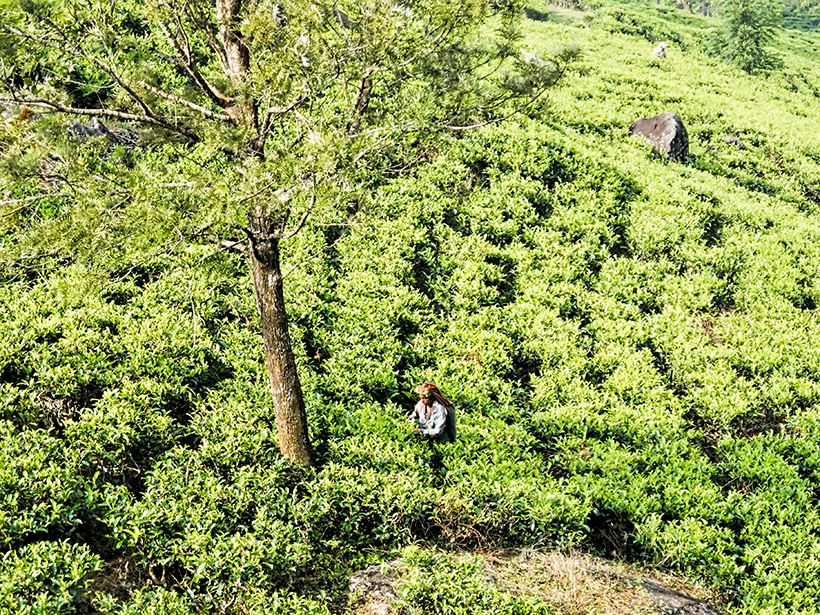After water, tea is the most commonly consumed beverage in the world. The tea plant, Camellia sinensis, is a perennial evergreen shrub that thrives in hot, moist climates. It prefers defined ranges of temperature and rain, specific types of soil, and certain elevations, making it rather persnickety about its favored growing area.
As climate change alters temperatures and rainfall, your daily cuppa (or three) might be under threat. Although scientists have previously considered how climate change could alter tea quality and quantity, new research published in Agricultural and Forest Meteorology takes a closer look at where future tea crops might be best grown in one of the world’s premier tea-growing nations, Sri Lanka.
Using climate model projections, researchers found that regions in Sri Lanka that are best suited for growing tea will decline by about 10.5% over the course of the next 30 to 50 years.
Growing Tea
Tea is a hot commodity. The Food and Agriculture Organization says worldwide demand for the brewed beverage is increasing, and the demand will continue to grow over the next decade. Tea consumption has grown 4.5% from 2006 to 2016.
All this tea comes from a few places in the world, where climate, soil, and elevation allow the plant to thrive. Sri Lanka is the fourth-largest producer of tea, generating more than 18% of global tea exports. Approximately a tenth of the Sri Lankan population is employed in the tea industry.
Currently, Sri Lanka sits within the global tea-growing zone, defined by the right amount of rain and a comfortable temperature range. That may not be the case in the next half century, say scientists, including Sadeeka Layomi Jayasinghe, a doctoral researcher at the University of New England in Australia and lead author of the new paper.
In their paper, Jayasinghe and her coauthor say future climate projections show that Sri Lanka will experience temperature increases from 0.4°C to 3°C every year over the next 30–50 years. Along with that ratcheting heat, rainfall patterns are expected to increase in amount while falling in uneven distributions.
On the basis of the modeling, rainfall was the biggest influence on tea growth.
Although other research has looked at how climate will affect tea quality and quantity, the team decided to look at geography—exactly where tea would thrive in a future climate. “No previous assessment of climate suitability has been undertaken in Sri Lanka [on] the impact of climatic variation on tea cultivation distribution,” Jayasinghe says.
Understanding where a crop grows best is a combination of biotic and abiotic factors, says Jennifer Burney, an environmental scientist at the University of California, San Diego, who was not involved in the study. Biotic factors include elements associated with the tea plants themselves, such as soil microbes. Abiotic factors are the nonliving physical parts of the environment, such as weather.
“It’s where the plant’s properties and the physical environment are most complementary,” Burney says. “The study authors are focused on the physical changes.”
Using more than 1,300 data points spanning tea-growing districts in Sri Lanka, the researchers modeled current and future habitat suitability for tea across the island. They used two global climate models to look at changes in suitability of tea crops in years 2050 and 2070.
Jayasinghe says that on the basis of the modeling, rainfall had the biggest influence on tea growth. “Precipitation seasonality was the most influential and contributed 67.6% to the distribution model,” she says, adding that temperature changes are responsible for almost 16% of the changes.
“I think the seasonality piece is an interesting note,” Burney says, adding that changing average precipitation levels, the seasonality of precipitation, and more extreme and variable precipitation all factor into the suitability of growing tea.
“Tea is a perennial crop, so growers have a lot invested in these plantations and cannot adapt on a year-to-year basis.”
In particular, Burney notes that the combination of shifting precipitation with warmer temperatures can create big problems for crops. “For example, if at present the hottest month is also the wettest, but in the future that timing shifts, it can be a ‘double punch’ for crops.”
“Climate suitability classes can be categorized as unsuitable, marginal, medium, and optimal,” explains Jayasinghe. She says that comparing current and future distributions of tea, she and her colleague found a decline of about 10.5%, 17%, and 8% in total optimal, medium, and marginal areas, respectively.
“A 10% decline in optimal tea-growing area is pretty big,” Burney says. “Especially when there are also losses in moderately and marginally suitable land.”
And in a country like Sri Lanka, the health and sustainability of tea are a big deal. Burney says tea is a critical crop in Sri Lanka—important for the local economy in terms of both revenue and employment. “Tea is a perennial crop, so growers have a lot invested in these plantations and cannot adapt on a year-to-year basis.”
Future Tea
Jayasinghe says that with future climate change “tea may not grow in some of the areas where it is currently grown if no suitable adaptation measures are implemented.”
She says she hopes the research can be used in management decisions by tea plantation owners.
“This study has yielded useful information for prospective stakeholders for making the tea production system more climate resilient,” Jayasinghe says, adding that the study identifies areas that could potentially be suitable for establishing new tea plantations in Sri Lanka.
Burney says that the climate impacts shown in this study may occur in the not-too-distant future—only 30 to 50 years from now. “This is a study that points to the need for adaptation.”
—Sarah Derouin (@Sarah_Derouin), Freelance Journalist
Citation:
Derouin, S. (2019), Climate change could threaten your cuppa, Eos, 100, https://doi.org/10.1029/2019EO129903. Published on 05 August 2019.
Text © 2019. The authors. CC BY-NC-ND 3.0
Except where otherwise noted, images are subject to copyright. Any reuse without express permission from the copyright owner is prohibited.

